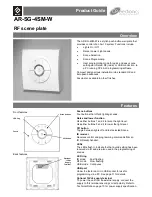
SARA-G3 and SARA-U2 series - System Integration Manual
UBX-13000995 - R26
System description
Page 55 of 217
The time period between two paging receptions is defined by the current base station (i.e. by the network):
If the module is registered with a 2G network, the paging reception period can vary from ~0.47 s (DRX = 2,
i.e. 2 x 51 2G-frames) up to ~2.12 s (DRX = 9, i.e. 9 x 51 2G-frames)
If the module is registered with a 3G network, the paging reception period can vary from 0.64 s (DRX = 6,
i.e. 2
6
3G-frames) up to 5.12 s (DRX = 9, i.e. 2
9
3G-frames)
The time period of the UART enable/disable cycle is configured differently when the module is registered with a
2G network compared to when the module is registered with a 3G network:
2G: the UART is synchronously enabled to every paging reception on SARA-G3 modules, whereas the UART
is not necessarily enabled at every paging reception on SARA-U2 modules: the UART is enabled concurrently
to a paging reception, and then, as data has not been received or sent, the UART is disabled until the first
paging reception that occurs after a timeout of 2.0 s, and therefore the interface is enabled again
3G: the UART is asynchronously enabled to paging receptions, as the UART is enabled for ~20 ms, and then,
if data are not received or sent, the UART is disabled for 2.5 s, and afterwards the interface is enabled again
Not registered: when a module is not registered with a network, the UART is enabled for ~20 ms, and then,
if data has not been received or sent, the UART is disabled for ~2.1 s on SARA-G3 modules or for 2.5 s on
SARA-U2 modules, and afterwards the interface is enabled again
The module active mode duration outside an active call depends on:
Network parameters, related to the time interval for the paging block reception (minimum of ~11 ms)
Duration of UART enable time in absence of data reception (~20 ms)
The time period from the last data received at the serial port during the active mode: the module does not
enter idle mode until a timeout expires. The second parameter of the +UPSV AT command configures this
timeout, from 40 2G-frames (i.e. 40 x 4.615 ms = 184 ms) up to 65000 2G-frames (i.e. 65000 x 4.615 ms =
300 s). Default value is 2000 2G-frames (i.e. 2000 x 4.615 ms = 9.2 s)
The active mode duration can be extended indefinitely since every subsequent character received during the
active mode, resets and restarts the timer.
The timeout is ignored only by SARA-U2 modules immediately after AT+UPSV=1 has been sent, so that the
UART interface is disabled and the module may enter idle mode immediately after the AT+UPSV=1 is sent
The hardware flow-control output (
CTS
line) indicates when the UART interface is enabled (data can be sent and
received over the UART), if HW flow control is enabled, as illustrated in Figure 28.
time [s]
CTS ON
CTS OFF
UART disabled
~10 ms (min)
UART enabled
~9.2 s (default)
UART enabled
Data input
0.47- 2.10 s
Figure 28: CTS behavior with power saving enabled (AT+UPSV=1) and HW flow control enabled: the CTS output line indicates
when the UART interface of the module is enabled (CTS = ON = low level) or disabled (CTS = OFF = high level)
















































